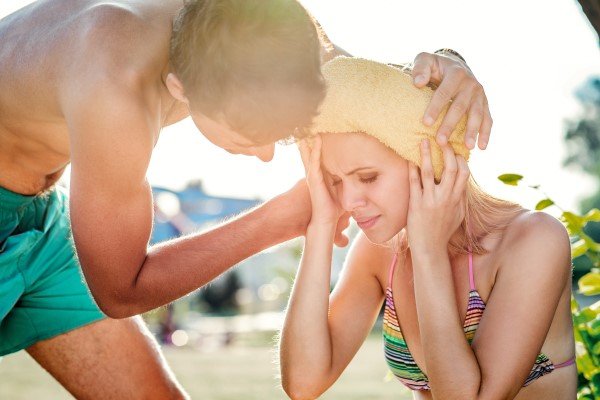Summer has arrived in Northwest Ohio and Southeast Michigan. At Hawaiian Pool Builders, we know how much you love to be in your pool, however, it’s also a great time to get outdoors to exercise. As the temperature climbs, so does the chance of getting heatstroke. Here are a few ways for avoiding heatstroke during exercise.
Reset your timing
Traditionally, we think, ‘the higher the sun in the sky the higher the temperature’. Climate science tells a different story. There’s actually a time lag between the time when the sun reaches its zenith, and the time the radiant heat reaches earth. Typically, the mercury tops out closer to 3:30 p.m. Therefore, not only should you not go out for your lunch hour run, you should hold off exercising outdoors anytime between 10:00 a.m. and 5:00 p.m. There will also be those days – the dog days of summer – where exercising outside simply isn’t smart at all. The temperature, coupled with the humidity can cause the heat index to be too high to safely exercise outside.
Instead, we recommend you:
- Wake up before the sun to avoid the heat from the sun and the ground. The ground will have released a lot of the heat it absorbed the day before during the night, keeping the ground cooler.
- Burn off the stress of the day with a late afternoon or early workout when the sun rays are more slanted, offering a longer shadow.
- Split your workout into two sessions – one for the morning, one for the evening.
Wear the appropriate clothing
Did you know that your internal temperatures can rise as much as 20 degrees during a cardio workout? That is the case even when exercising in cooler temperatures. Making sure you have on the appropriate clothing and wearing the right accessories can make all the difference in the world.
- Think light. Clothing that is light in weight and in color will help deflect the sun’s hot rays. There are many different choices of clothing when it comes to moisture-wicking athletic wear. This type of clothing pulls the sweat away and allows your body to evaporate and cool down more quickly.
- Cool your pulse points with wristbands, headbands, and neck towels that are designed to pull moisture away from your body while staying cold to the touch.
Stay hydrated
Heat equals sweat; and that equals loss of water. Before you exercise, either indoors or out, weigh yourself. Weigh again after your workout, and you are likely to find your post-workout weight is lower. The fact is, 99% of that lost weight is from water. Exercising in high heat will make you lose body water more quickly than working out in normal temperatures. Your body cannot function properly if it’s dehydrated.
Here’s a few ways to help you stay hydrated:
- Eat your liquids. Fruits and vegetables are a great source of water, providing on average 20% of your daily intake of water.
- Drink tepid liquids. Water and drinks that are rich in electrolytes, sodium and potassium should be consumed at room temperature – i.e., tepid temperature. The body will reject liquids that are too cold when it’s hot.
- Refrain from drinking fluids before a workout that cause dehydration. That includes soda, coffee and alcohol.
Change your routine
Our body needs a change of routine to keep our muscles guessing. Use the summer to practice new forms of exercise that compliments your typical regimen. The change allows you to focus on different muscle groups and/or other skills like lifting or balancing.
Here’s some ideas for you:
- Jump into your pool. Not just to splash around, but use it for exercise. If your pool is long enough, do
laps. You could also dive for weights. Doing your regular exercise in the pool can offer a better workout as the water works against you. Besides, you’ll stay cooler that way. - Go for a hike. You use a different set of muscles walking across uneven terrain then you do when you walk down the street. The nice part about living in Northwest Ohio and Southeast Michigan, is that we are fortunate to have many parks that offer great hiking trails, and many keep you in the shade.
- Take a yoga class. It’s easy to find yoga or Tai-Chai classes that are offered outside. Both are considered low impact exercise, but don’t underestimate the difficulty of slow, controlled movements.
Join a gym
Exercising indoors presents fewer risks of overheating than exercising outdoors. Though, even in the dead of summer, the indoor temperature with adequate air conditioning can still vary from 68-74 degrees, or more. Just remember, as we stated, your core temperature can still go up 20 degrees to the surrounding temperature.
Most importantly, listen to your body. There’s a time to push yourself, and there’s a time to stop. Your body has a built in ‘stop point’ where you have reached a maximum temperature. You will know when you are close to that point. If you feel dizzy, stop your workout immediately and find a way to cool your body down. One quick way is to run cool, not cold water over your wrists for a few minutes. This will cool the blood traveling back to the heart, and it’s a fast way to lower your core temperature.
As important as the above tips and tricks are to avoiding heatstroke, it’s equally as important to understand and know the symptoms:
- If you or someone you are with has stopped sweating. Sweating is your body’s natural defense mechanism against heatstroke. However, you will stop sweating if you are experiencing heatstroke.
- Chills
- Severe, migraine-like headaches
- Trouble talking
- Dizziness and/or vertigo
- Skin is hot to the touch
- Elevated heart rate
Heat exhaustion is less severe condition associated with prolonged exposure to high heat. It’s characterized by the body’s loss of electrolytes. In cases of heat exhaustion, you will lose your electrolytes, which can result in a rapid pulse, excessive sweating, muscle weakness, vomiting, and lethargy.
Above all, we want you to enjoy your summer. Don’t let heatstroke or heat exhaustion stand in your way.







